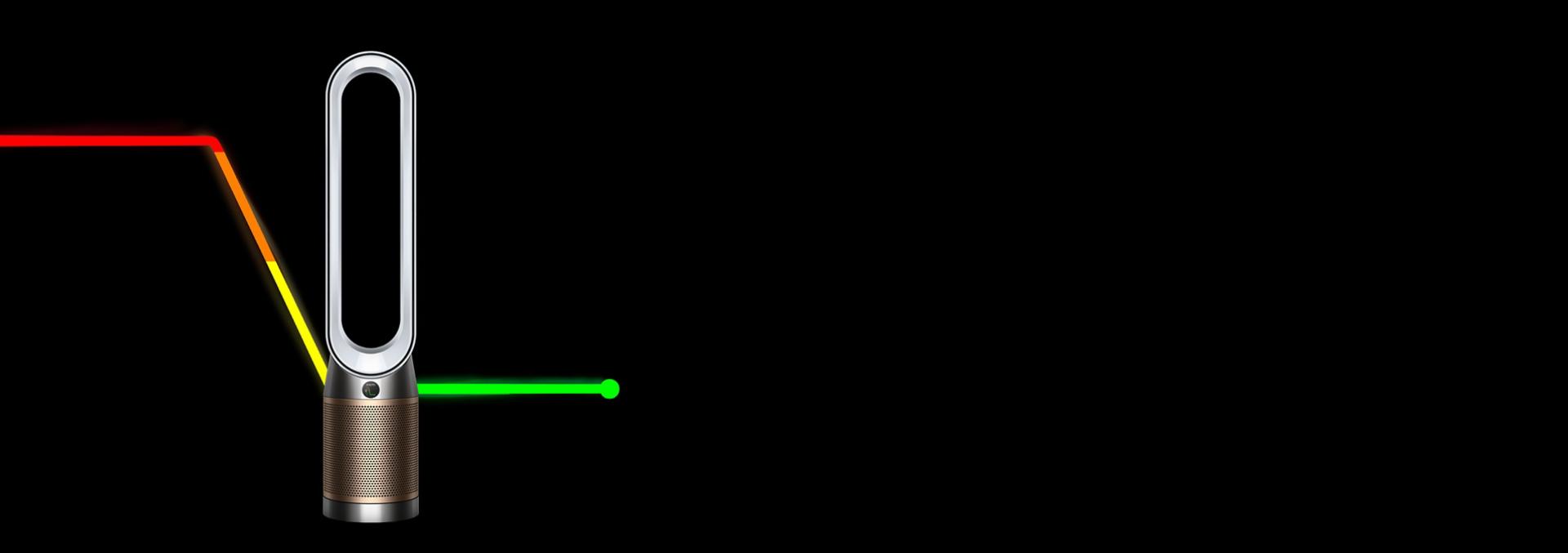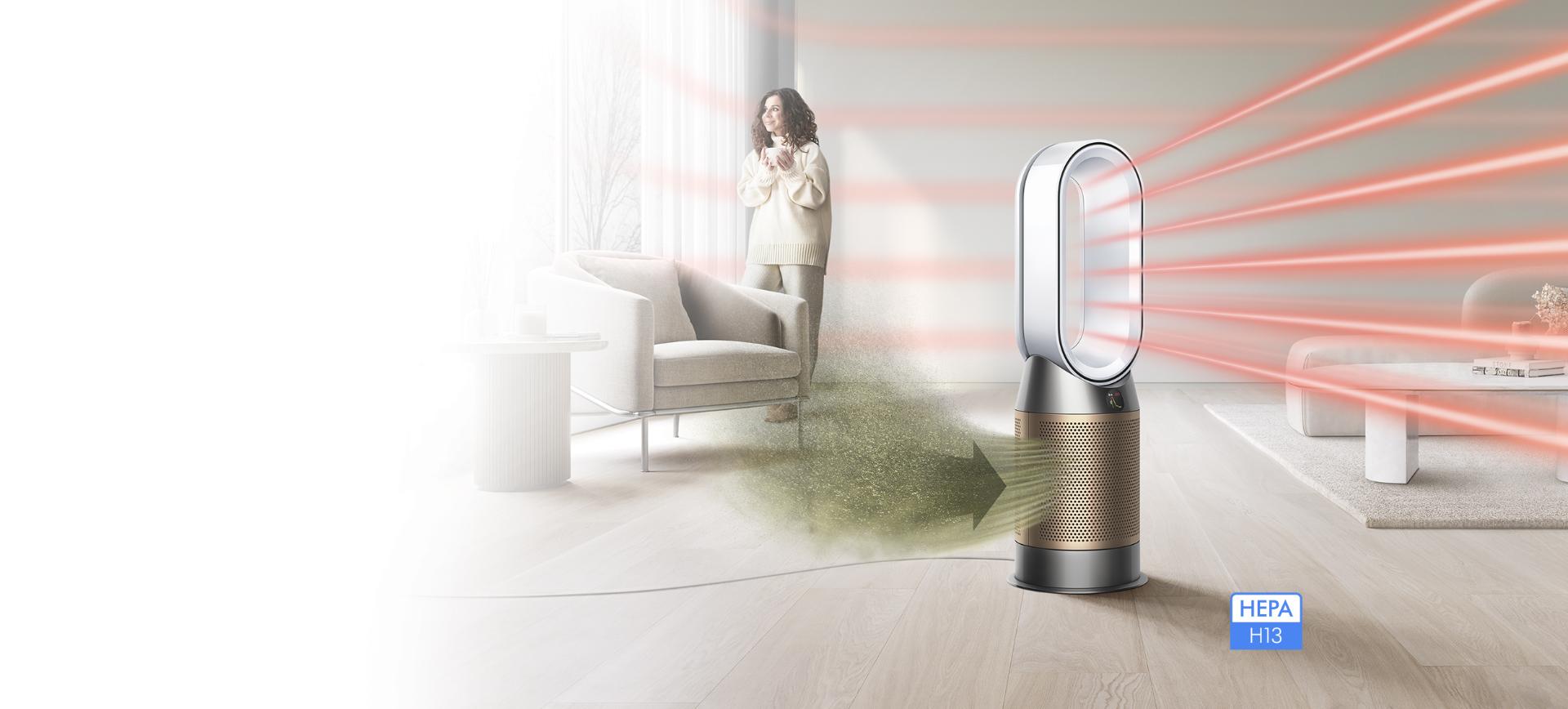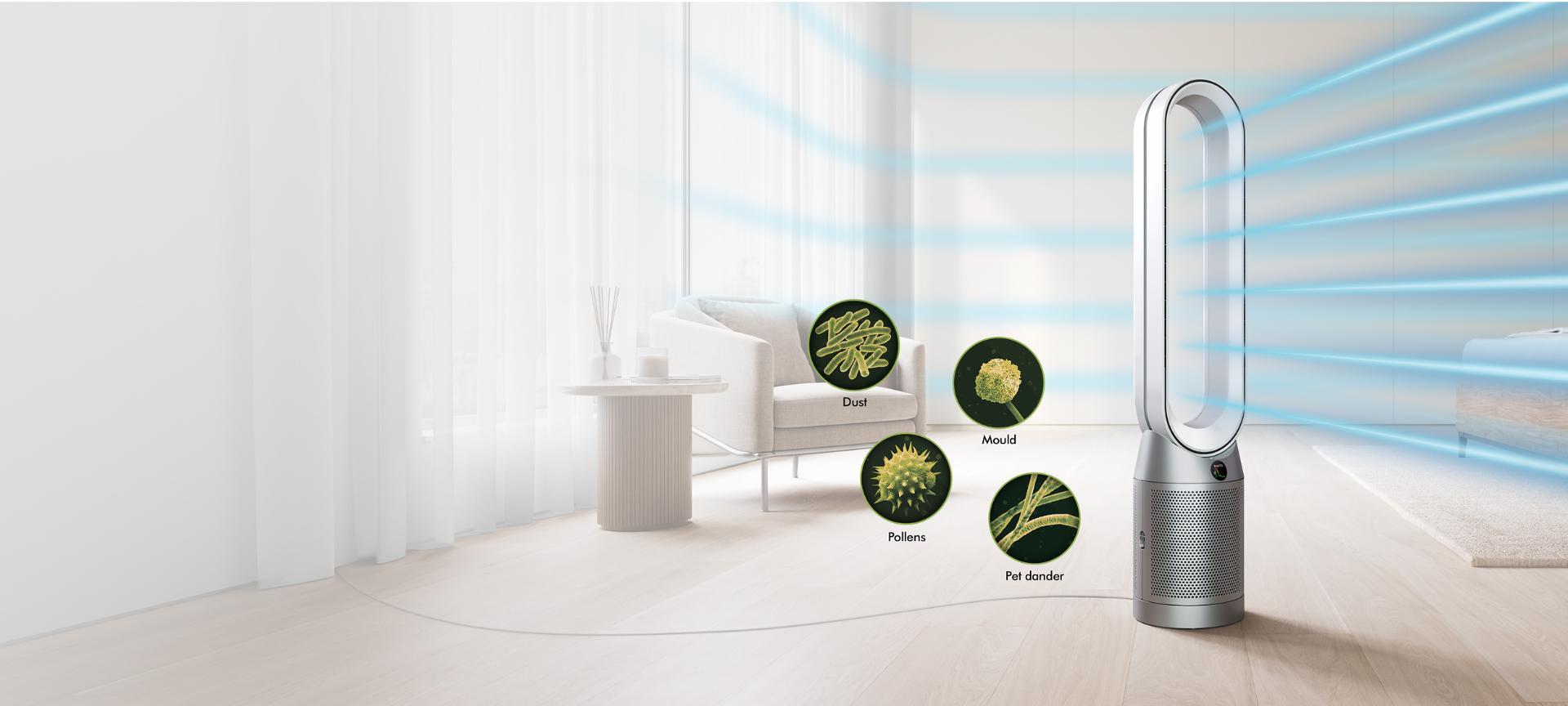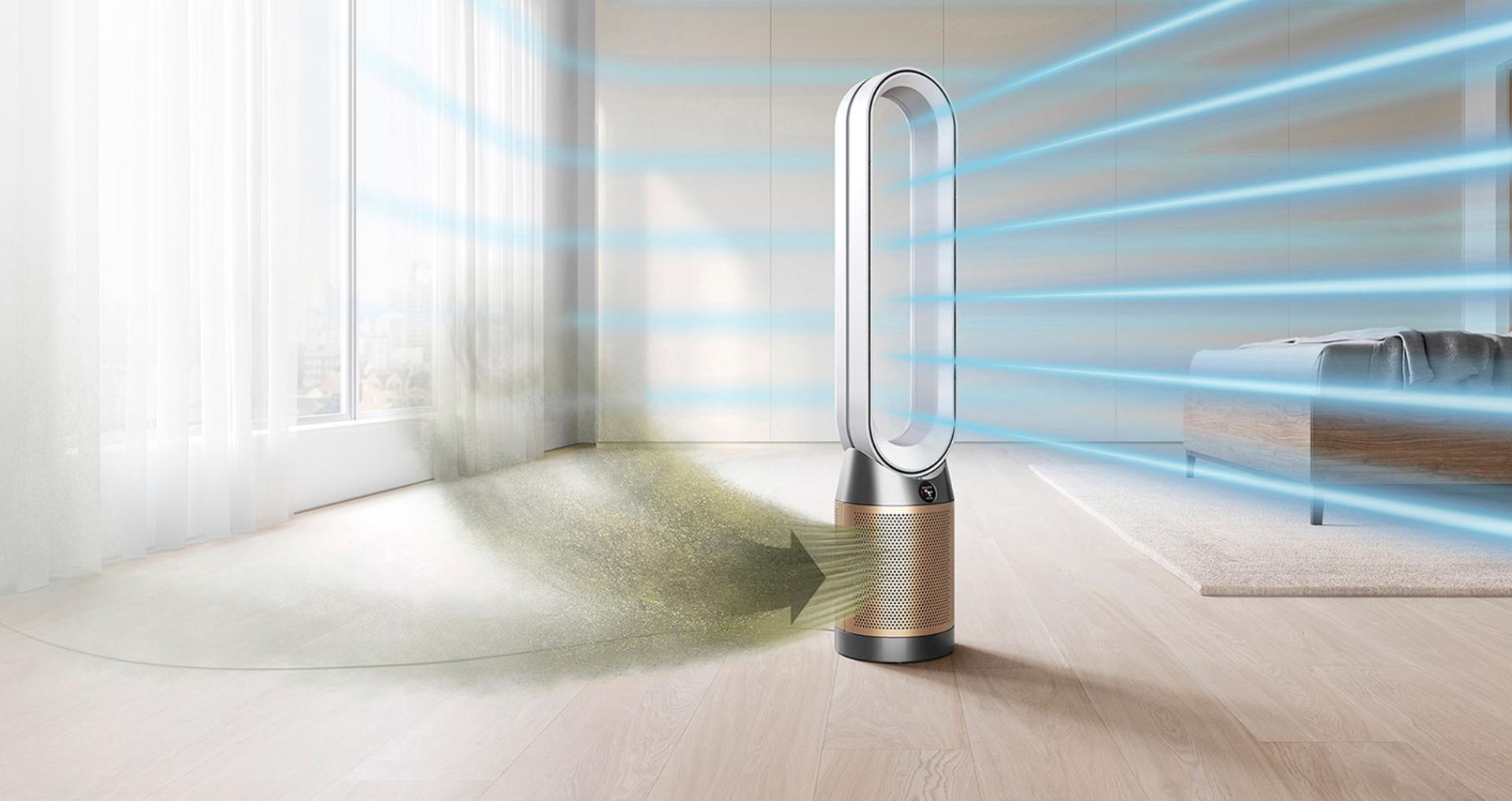Guide | September 18, 2023
How to choose a Dyson Air Purifier for your home
Different indoor environments have unique air filtration needs. The function of each space – whether it be cooking, working, cleaning or sleeping can affect which particles and pollutants are present. These particles – both visible and hidden – can accumulate in the home, triggering allergic reactions or exacerbating conditions like asthma.
Monika Stuczen, Dyson Microbiologist explains the potential impacts of pollution on wellbeing. “Just because it is out of sight does not mean it should be out of mind. Microscopic dust particles like pet dander and dust mite allergens may impact your wellbeing.”
Introducing an air purifier for allergies and asthma can help eliminate common triggers in the home such as mould, animal dander, dust and pollen. With more work-from-home arrangements and time spent indoors, superior air quality is essential. It’s also important to align your purifier filtration settings to your home’s physical dimensions, along with your desired temperature and sound levels.
To understand which air purifier is best for your space, we analyse everyday household sources that emit various pollutants. Whether you need an air purifier for allergies or to simply improve indoor air quality in the home, compare Dyson purification technology below.
How does an air purifier work?
Air purifiers are designed to sense, capture and trap unwanted airborne particles from a room – this is how air purifiers work to combat common household pollutants. Once these pollutants are detected, clean and purified air is then projected back into the room. While the air purifier is in use, this filtration process happens continuously to enhance your home’s air quality. When we breathe in cleaner air, it can improve our overall health and wellbeing, while alleviating allergy and asthma symptoms.
What pollutants can be found at home?
Dyson’s research into air science uncovers the various indoor and outdoor pollutants that can appear in the home.
Common allergens that can build up the home:
- Pet dander – this can trigger asthma symptoms
- Dust mites – a big hay fever trigger
- Mould – can grow in damp, humid areas
Some surprising sources of pollutants include:
- Cleaning products
- Home materials like paints and furniture materials
- Indoor cooking fumes
- Wood Heater & candles
- Cosmetics like lotions, nail polish and aerosols
Outdoor pollutants can also access homes through open windows and doors. Types of outdoor pollutants can include:
- Vehicle exhaust fumes & brake dust
- Pollen allergens
- Gardening products
Dyson’s latest air purifiers for allergies and other household irritants are sealed to HEPA 13 standard1 to prevent pollutants from being expelled back into the room after they've been removed from the airflow.
What to look for in an air purifier for allergies and asthma
Most of us are aware of the allergens and pollutants that we can encounter outdoors, but did you know that the air in our homes can be up to five times more polluted than outside? This can make us vulnerable to allergies – even in our own homes. Air purifiers for allergies and asthma are designed to detect and remove harmful airborne particles indoors, promoting cleaner air and eliminating the source of allergy triggers.
As with our vacuum technology, Dyson purifier filtration capability is achieved through the combination of airflow technology and filtration. Conventional air purifiers often only draw in and project a limited amount of air within each space. A Dyson air purifier projects clean air around the whole room2 using Air Multiplier™ technology.
HEPA filtration: HEPA, which stands for High Efficiency Particulate Air, is a standard of filter efficiency. To meet HEPA criteria, our machines remove a minimum of 99.95% of particles as small as 0.1 microns3 and are sealed to HEPA H13 standard1. This means when airborne allergens like pollen, mould, pet dander and dust mites are detected and trapped, they stay inside your machine.
Gaseous filtration: Aside from particle matter, indoor spaces in the home and office can generate potentially harmful gaseous pollution. Indoor sources can include VOCs released by household products such as cleaning sprays. Outdoor sources can include pollutants such as NO₂ from vehicle emissions and fumes, which can be brought in through open windows and doors. The Dyson air purifier range can help to create cleaner air through the use of an activated carbon filter, which captures gases4.
Noise: Advancements in technology means our range is now acoustically engineered to reduce turbulence, making our machines 20% quieter than previous models7. Night mode monitors and purifies the air continuously with the quietest settings, alongside a dimmed display.
How to choose the best air purifier for removing pollutants
When looking for your ideal air purifier, it’s important to consider all variables of your home before making a decision.
-
Allergies
One of the major reasons to purchase an air purifier is to capture allergens. The best way to improve air quality in your home is to detect and destroy allergens that impact your health such as pollen, animal dander and dust. It’s important to understand which allergens a purifier can filter. Air purifiers with a HEPA filter are recommended, as they expose and remove everyday allergens, giving you the clarity and comfort of breathing cleaner air.
-
Asthma
Hay fever affects many people around the world, notably in major cities where the pollen count is high. Seasonal allergies are commonly triggered by plants and grass – and many non-native trees are the culprit. London Plane trees are one example, typically planted along pavements and parklands in inner-city areas. Plant pollen can easily make its way into your home, either tracked inside on hair and clothing, or filtered in through open windows. However, using an air purifier for allergies like hay fever can help eliminate pollen and other harmful pollutants.
-
Pollen
The longer your air purifier can operate, the better your results. Consider if you want your air purifier running constantly or in intervals. If your air purifier will be on frequently, contemplate the noise setting of the filtration. Thirty decibels or lower should allow a quiet night’s sleep. If your air machine will be operating in your bedroom, look for a purifier with a night mode feature.
-
Room size
When looking for an air purifier for allergies and asthma, room size is going to be a factor, so you should consider where your air purifier will be placed. For a bedroom or office, we suggest a small to medium-sized machine. For a living room or spacious open-plan kitchen setting, you may need a larger purifier to efficiently filter clean air throughout the whole room.
-
Allergens and pets
While animals can often induce allergies or asthma symptoms in humans, your pets can also experience allergies of their own in the form of dust mites, mould and pollen. If you notice your pet is sneezing a lot or scratching more than normal, they might be sensitive to airborne irritants – just as you can be. Along with other members of your family, you can use an air purifier for pets, protecting them from harmful airborne particles.
-
Filtration frequency
An air purifier is going to be most effective when it operates consistently in the home. If you plan to run your purifier throughout the day, it should be quiet enough that it doesn’t disrupt your lifestyle or work schedule. When sleeping, an air purifier should be below 30 decibels to avoid sleep disturbance. If you’re looking for a bedroom-specific air purifier, ensure it can be switched to night mode.
-
Heating, cooling and humidifying
Modern developments in air purification offer more than just clean air. A range of purifiers now provide heating, cooling and humidifying capabilities to better suit the needs of a space. Determine whether you simply want air filtration or additional temperature benefits as well.
-
Smoke haze
If anyone smokes in your home, consider choosing a machine that purifies smoke. Similar to allergens, smoke can also be eliminated from the air. Some purifiers will contain a charcoal or active carbon filter to support smoke removal and provide cleaner air.
-
App connection
Many manufacturers will deliver apps that can be synced to air purifiers. Such apps allow you to adjust the settings of your smart machine using a smart device. Apps like MyDyson™ can also prepare and present air quality reports and will notify you if your purifier requires a new filter or maintenance.
-
Which air purifier is best for your home?
Now that you have determined you need an air purifier for allergies, asthma, pet dander, mould or other airborne pollutants, discover the difference between each Dyson air purifier machine below.

Dyson Purifier Hot+Cool™ Formaldehyde
The latest in Dyson’s purification technology is equipped with solid-state formaldehyde sensing technology. Dyson Purifier Hot+Cool™ Formaldehyde destroys dangerous VOCs including formaldehyde, alongside capturing ultrafine dust and allergens5

Engineered with total temperature control and smart-home enabling, this Dyson purifier also contains a catalytic filter that destroys formaldehyde5, eliminating harmful airborne particles in the home that would otherwise go undetected.
-
Filtration technology:
included in the machine is three stages of filtration. A HEPA+Carbon filter removes odours and gases such as nitrogen dioxide, and 99.95% of particles such as dust mites and pollen as small as 0.1 microns3. Formaldehyde, a potentially harmful pollutant which can off-gas within the home, is captured and converted into tiny amounts of water and CO2
-
Heating and cooling technology
Air Multiplier™ technology projects purified air to heat and cool rooms evenly. Once the target temperature is reached, heating automatically stops. To cool the room quickly, over 290 litres of air a second are projected. Auto mode enables the machine to maintain a preferred room temperature and air quality levels, while the machine can be entirely controlled by the MyDyson™ App and activated by voice control6.
Dyson Purifier Hot+Cool™
Dyson’s temperature control model projects both hot and cool purified air. Dyson Hot+Cool™ helps to regulate room temperature via Air Multiplier™ technology.

Temperature regulation plays an important role in falling asleep, so if you are selecting an air purifier for allergy-fighting capabilities in the bedroom, opt for the Dyson Hot+Cool™. Enjoy heating and cooling options along with a Night mode function to purify air and regulate room temperature on quiet and dim settings.
-
Filtration technology:
two layers of filtration capture ultra- fine dust particles, pollutants, odour and VOCs. The HEPA H13 standard1 filter removes 99.95% of particles as small as 0.1 microns3. It isn’t only the filter which is sealed to such high standards but the whole machine, to ensure pollutants remain captured.
-
Heating and cooling technology
heating and cooling can be achieved quickly and across the whole room2. Once the target temperature is reached, heating automatically stops. To cool the room quickly, over 290 litres of air a second are projected. The diffused mode purifies without cooling you, by diverting airflow through the back of the machine and maintaining effective purification.
Dyson Purifier Cool™
Dyson’s purifying fan projects purified air to cool rooms down whilst capturing potentially harmful dust and allergens. Air Multiplier™ technology projects a stream of powerful, smooth and high-velocity airflow. Dyson Purifier Cool™ projects cleaner air, making it easy to choose an air purifier to improve comfort as you spend time indoors.

If your priority is cleaner, cooler air in your living quarters, the Dyson Purifier Cool™ is the perfect option – capturing harmful dust and allergens while projecting a cool flow of air throughout the entire room.
-
Cooling technology
Alongside air filtration, does the Dyson fan actually cool the air? When heat increases during summer, it impacts outdoor air quality and pollution – which can easily filter into your home. So, in addition to comfortably cooling your home, this Dyson air purifier also protects your health and wellbeing.
-
Filtration technology:
Two stages of filtration capture pollutant and particles alongside odours and VOCs. The HEPA H13 standard1 filter removes 99.95% of particles as small as 0.1 microns3. It isn’t just the filter which is sealed to such high standards but the whole machine, so what goes inside, stays inside.
Dyson Purifier Cool™ Formaldehyde
Dyson’s purifying fan with advanced formaldehyde capturing filtration. It combines a precise solid-state formaldehyde sensor with a unique catalytic filter that continuously destroys formaldehyde. HEPA H13 and activated carbon filters also capture dust, allergens, gases4 and other ultrafine pollutants. And Dyson purifiers have powerful Air Multiplier™ technology to purify the whole room.2

-
Cooling technology
a powerful stream of purified airflow works to cool down interior spaces. The cooling effect results from air being projected from the amplifier at velocity. The higher the fan speed, the more powerful the airflow, and cooler the air will feel.
-
Filtration technology:
Three stages of filtration are included in this Dyson fan purifier. A HEPA+Carbon filter removes odours and gases such as nitrogen dioxide4, and 99.95% of particles such as dust mites and pollen as small as 0.1 microns3. It also combines a precise solid-state formaldehyde sensor with a unique catalytic filter that continuously destroys formaldehyde5, a harmful pollutant found in many home materials.
Now that you know which air purifier is best for your home, learn how to clean a carpet effectively.
2. Tested for air projection, purification coverage in a 81m3 room and heating performance in a 35m3 room.
3.Tested for filtration efficiency at 0.1 microns (EN1822).
4. Gas capture rates may vary.
5. Third party full machine testing based on GB/T 18801-2015 formaldehyde cumulative clean mass testing with continuous injection until plateau of formaldehyde CADR is achieved. Results may vary in practice.
6. App functionality may vary per market. Requires Wi-Fi and app enabled device. Standard data and messaging rates may apply. Requires iOS version 10 or above, or Android version 5 or above. Your mobile device must have Bluetooth 4.0 support.Refer to the MyDyson app for compatible smart home devices and voice services .
7. Compared to Dyson Pure Cool™ TP04